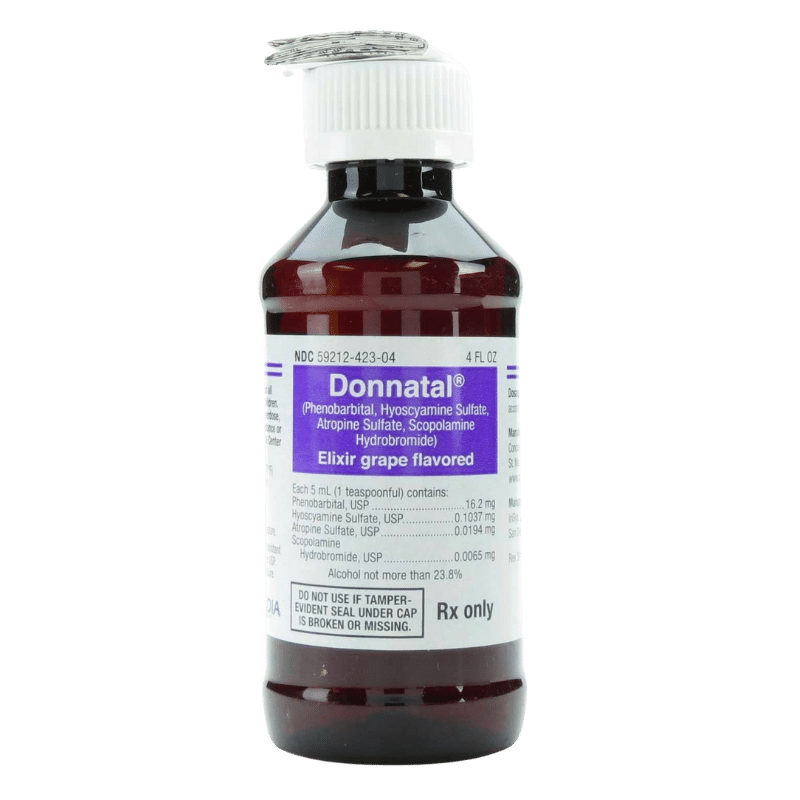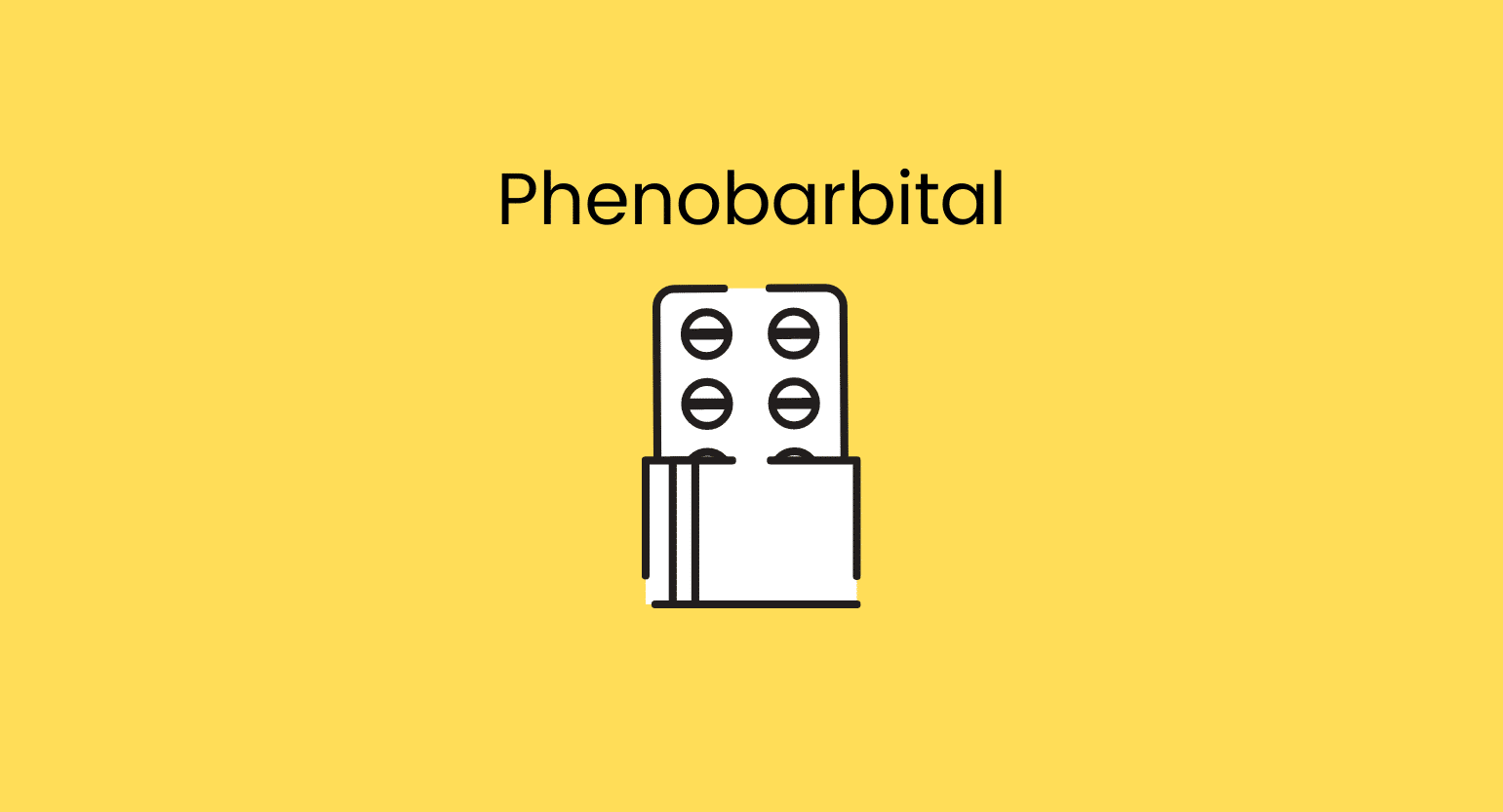Does Kratom Interact With Phenobarbital (Luminal)?
Yes — even though this interaction is unusual, it is still very dangerous. Combining kratom and barbiturates like phenobarbital is highly risky.
First, phenobarbital —known under the brand name Luminal —is a CYP450 enzyme inducer. This means that phenobarbital increases the effectiveness of CYP450 enzymes, speeding up the elimination of drugs metabolized by the CYP system, like kratom.
Phenobarbital can increase the rate of kratom’s metabolism, decreasing the herb’s half-life and making it less effective.
Moreover, because phenobarbital is a central nervous system depressant, taking it along with kratom increases the risk of experiencing severe respiratory depression and overdose. When you take two drugs that cause similar effects on the body, their effects can potentiate, leading to a more intense overall experience. This phenomenon is known as an agonistic interaction.
Because phenobarbital suppresses the central nervous system, it’s too easy to overdose on it. If you add kratom on top of it, that’s a recipe for disaster. It’s best to avoid any drugs that could potentiate phenobarbital’s effects.
Is it Safe to Take Kratom With Phenobarbital (Luminal)?
No, this combination is anything but safe. Because phenobarbital (Luminal) is a barbiturate, it’s best to be extremely cautious and avoid using kratom with the drug. Consult with your doctor before combining kratom and other supplements or medications.
What is Phenobarbital?
Phenobarbital, known by its trade name Luminal, is a barbiturate medication commonly used to treat seizures, as well as anxiety and other sleep disorders [1].
Barbiturates are a class of compounds derived from barbituric acid [2]. They are hypnotic sedatives used for anesthetic purposes too.
Discovered in 1912, phenobarbital is one of the oldest seizure medications. It is registered by the DEA as a Schedule IV compound, meaning it has legitimate medical uses but carries a low potential for abuse, which can turn into dependence.
Phenobarbital Specs

| Drug Name | Phenobarbital |
| Trade Name | Luminal |
| Classification | Barbiturate |
| CYP Metabolism | CYP2C9, CYP2C19 |
| Interaction With Kratom | Metabolic induction, Agonistic |
| Risk of Interaction | Moderate to high |
What is Phenobarbital Used for?
Phenobarbital mainly treats all types of seizures [1].
However, even though phenobarbital has proven effectiveness in treating seizures, it has mostly been replaced by medications that cause fewer adverse effects.
Phenobarbital is also commonly used for other purposes:
- Doctors have prescribed phenobarbital to treat anxiety-related conditions [3].
- Phenobarbital has been used to treat withdrawal symptoms stemming from different types of drug use [4].
- Lastly, phenobarbital can also help treat issues related to insomnia and anxiety [5].
What’s the Dose of Phenobarbital?
It’s best to contact your doctor if you have doubts about your phenobarbital prescription.
Phenobarbital has specific characteristics only a qualified medical professional can handle, such as an unusually long half-life. It also has several contraindications that might make it potentially dangerous.
Generic & Brand Name Versions
Some of the brand names for phenobarbital are:
- Donnatal
- Luminal
- Solfoton
- Tedral
What Are the Side Effects of Phenobarbital
Phenobarbital’s most common side effects are lack of coordination, impaired balance, and drowsiness. Other common side effects associated with phenobarbital include [1]:
- Agitation
- Confusion
- Irritability
- Nervousness
- Nightmares
- Somnolence
Rarer but more severe side effects are:
- Coma
- Decreased effort to breathe
- Low blood pressure
- Steven-johnson syndrome
- Suicidal ideation
Long-term use of phenobarbital has been associated with the following:
- Bone aches
- Depression
- Liver damage

What is Kratom?
Kratom (Mitragyna speciosa) is a type of tree native to countries in Southeast Asia, including Vietnam, Indonesia, Malaysia, and Thailand. In these countries, local farmers and indigenous people have used kratom for centuries to combat fatigue and pain. In recent years, kratom has just become known in the western world.
Kratom owes its magnificent properties to the natural alkaloid compounds found inside it. The two most important are mitragynine and 7-hydroxymitragynine.
Kratom acts on the body’s opioid receptors, giving it potent painkilling abilities, but it is much safer.
What is Kratom Used for?
As mentioned before, kratom has a vast spectrum of uses.
When consumed in low doses, kratom acts as a stimulant and can produce powerful cognitive benefits, just like coffee and the coca leaf!
Small amounts can stimulate euphoria and promote mental and physical energy.
However, the larger the amount, the more sedative the effects become. It goes from stimulant-like properties to providing potent analgesic and anti-anxiety benefits.
Other more singular uses for kratom have also been discovered:
- Alcohol withdrawal syndrome
- Arthritis
- Benzodiazepine withdrawal syndrome
- Chronic back pain
- Depression
- Fibromyalgia
- Migraine
- Psoriatic arthritis
- Opiate withdrawal syndrome

What’s the Dose of Kratom?
You should always be aware that formulaic dosage recommendations found on the internet can never be totally accurate. There’s just no way they can consider all the ways humans differ.
However, it’s still helpful to know the general dosage range.
The standard kratom dose is as follows:
- Low dose — 1-4 grams
- Medium dose — 4-8 grams
- High dose — 8-12 grams
For additional info, check out our kratom dosing guide.
What Are the Side Effects of Kratom?
Kratom, like all drugs, has its fair share of side effects:
- Constipation
- Dizziness
- Headaches
- Heart palpitations
- Insomnia
- Itchiness
- Loss of muscle coordination
- Nausea
The following are far less common but something to watch out for — these generally mean you took too much or need a long break.
- High or low blood pressure
- Liver damage (with long-term use)
- Low libido
- Nausea
- Poor appetite
- Seizures
- Tremors
Kratom can also cause symptoms of mental and physical dependence.
Kratom addiction is less likely when compared to pharmacological drugs like antidepressants or painkillers, but it’s always possible.
Make sure to become familiar with the dangers of kratom use.
What Are the Different Types of Kratom?
The kratom plants have four different types of strains: excellent news for those who like to experiment and tinker.
However, it’s not like they’re entirely different from one another. All kratom strains share the same basic spectrum of effects.
Their uniqueness is because each strain better emphasizes a different part of said spectrum.
White Vein Kratom
White vein kratom is the way to go if you want to focus on kratom’s cognitive benefits.
A white-veined kratom strain is a great option to replace your morning coffee!
Red Vein Kratom
Red vein kratom is extremely popular with those suffering from chronic pain or anxiety. This is because red-veined kratom strains are known to be relaxing and more potent pain-relievers.
Green Vein Kratom
Green vein kratom is a little different than white or red kratom. Instead of focusing on one end of the kratom spectrum, it provides a well-balanced experience with all of what kratom offers.
Yellow Vein Kratom
Yellow vein strains are the same as green, the only difference being that they are much lighter: perfect for first-timers or those with a sensitivity!

Key Takeaways: Is it Safe to Mix Kratom & Phenobarbital
It’s best to avoid using kratom with barbiturates — this combination could come with some high risks. Speak to your doctor first if you feel you could benefit from using kratom and phenobarbital.
Phenobarbital can also make your kratom less potent. Since phenobarbital has a half-life of unusually long duration, you might want to replace kratom with a compound that won’t have its potency reduced.
- Lewis, C. B., & Adams, N. (2021). Phenobarbital. StatPearls.
- Skibiski, J., & Abdijadid, S. (2021). Barbiturates. In StatPearls [Internet]. StatPearls Publishing.
- Mula, M., Pini, S., & Cassano, G. B. (2007). The role of anticonvulsant drugs in anxiety disorders: a critical review of the evidence. Journal of clinical psychopharmacology, 27(3), 263-272.
- Nisavic, M., Nejad, S. H., Isenberg, B. M., Bajwa, E. K., Currier, P., Wallace, P. M., … & Wilens, T. (2019). Use of phenobarbital in alcohol withdrawal management–a retrospective comparison study of phenobarbital and benzodiazepines for acute alcohol withdrawal management in general medical patients. Psychosomatics, 60(5), 458-467.
- Prinz, P. N., Vitiello, M. V., Roehrs, T. A., Linnoila, M., & Weitzman, E. D. (1981). Effect of phenobarbital on sleep and nighttime plasma growth hormone and cortisol levels. Canadian journal of physiology and pharmacology, 59(11), 1139-1145.

